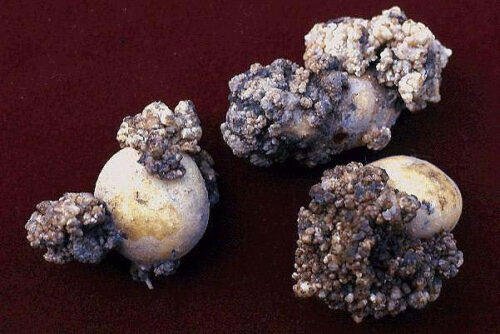Potato wart disease is caused by the fungus Synchytrium endobioticum.
Also known as:
Black wart, Black scab
Pota
Warty disease
Pota
Synchytrium endobioticum does not form a fungus phloem but sorals, in which spores are formed. The spores invade the epidermal cells of potatoes in spring and cause growths that swell into warts. The infected cells divide, creating more and more warts. In severe infestations, the warts grow into cauli
Wet soils with a soil temperature of at least 8°C are required for the development of the pota
In autumn, the warts rot away and release ‘resting’ spores. These spores rest in the soil and retain their germination capacity for up to forty years. The spores survive 11-12 hours survival at 100°C, composting for 12 days at 60-65°C and pasteurization for 90 minutes at 70°C. The spores also survive the way through the digestive system of animals that have eaten contaminated potatoes.
If wart disease is detected on a plot, that plot is declared infected and no potatoes may be grown for a long time until the plot have been found free of the disease .
Wart disease is a quarantine disease (EU), which is subject to strict legal regulations. Similarly, no other planting material (e.g. bulbs, trees and perennials) may be grown on an infected plots – anything to prevent the spread of the fungus.
Where to find
- Potato
Control
After infection, recovery is no longer possible.
Prevention
In some countries potatoes are subject to a cultivation regulation to prevent the spread and infection of the pota
Much research is being done on wart disease-resistant pota

